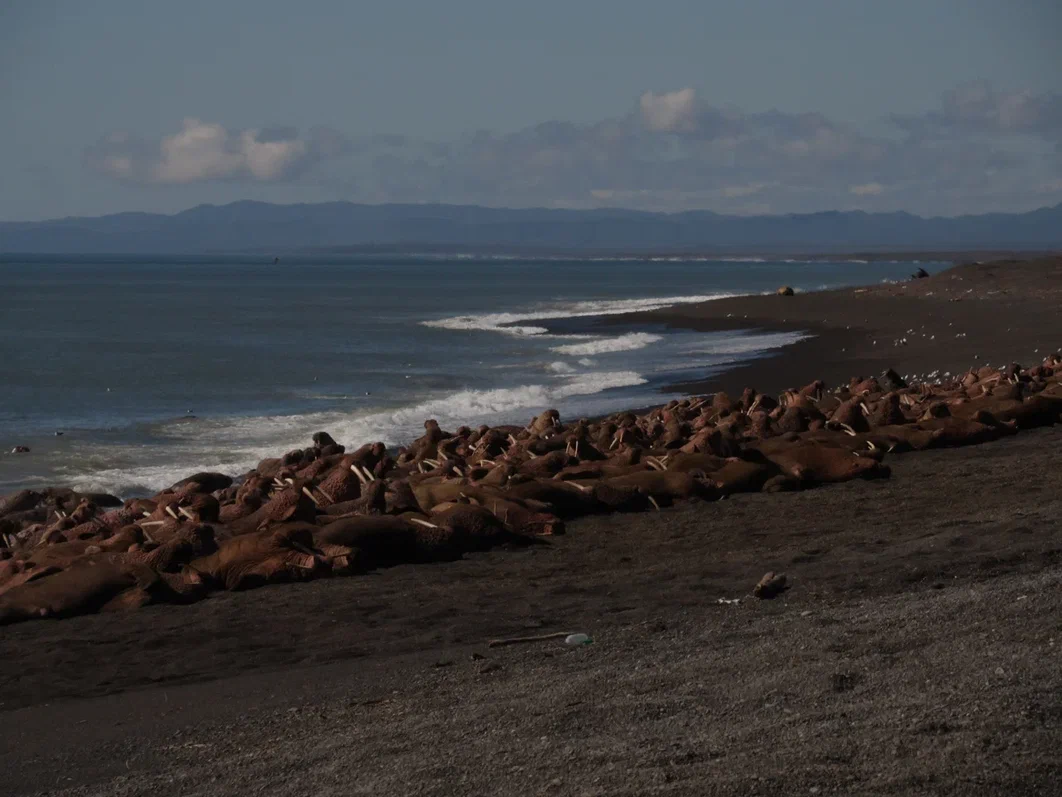|
|
Ivan Andreevich Golovnev
Doctor of Historical Sciences, Leading Researcher of the Centre for Arctic Research
Of the Peter the Great Museum of Anthropology and Ethnography (the Kunstkamera) RAS
|
Kereks. Spiritual Culture: Mythologies, Traditional Beliefs, Holidays, and Rituals
The traditional spiritual culture of Kereks was full of archaic beliefs – the cult of ancestors, the spiritualization of natural phenomena and totem animals, as well as rituals of remembrance in prayers and gratitude. Some artifacts of Kereks’ cult sacrificial sites have remained, for example, semicircles of walrus skulls with a whale jaw driven vertically into the ground. These sites were visited not only by Kereks, but also by the Chukchi and Koryaks in the past and served as the meeting ground for solving interethnic issues, conducting seasonal rituals, distributing hunting grounds, and concluding agreements.
Kereks believes that the world around them was inhabited by guardian spirits of various natural objects and creatures that interacted regularly with people. There was a good reason why Kereks had a custom of throwing out a burning firebrand from the hearths when the head of the family came back after a long absence – it was thought to frighten external energies that stuck on the man on his way.
Shamanism was an intermediary between the worlds of people and of spirits. Shamans predicated weather changes and potential luck in hunting, treated the sick, and conducted religious rituals. Kerek shamans commanded respect among the Chukchi and Koryaks. Female shamans were credited with special powers, for instance, “an old woman from the tribe of Kerek, the size of a finger.” Local shamans were skillful in the trick of self-stabbing with a knife, which strengthened the belief of their fellow tribesmen and tribeswomen in their supernatural immortality.
Kereks’ folklore consisted mostly of tales (fairy tales and animal tales), spells, and songs. The main character – the raven called
Kukki
– is idiosyncratic for the folklore of peoples of North East. The Kerek tales about
Kukki
had clear plotlines and contained many dialogues:
Kukki
played the part of a trickster, but in some plot lines he took part in the acts of creation. The main characters of Kerek tales were animals (i.e., the fox, the mouse, the seal, the reindeer, etc.), who had anthropomorphic features. Songs were a separate genre of Kerek folklore. Kereks thought that every person had their own personal song devoted only to that person which would accompany them throughout their life. There were as many songs as people, Kereks believed.
Kereks’ family, hunting, and calendar festivities were closely connected with traditional beliefs. The transitional stages of human life – birth and death – were celebrated by meaningful rituals. Kereks thought that children were dead ancestors (mostly of the maternal line) who came back to the world of the living. In accordance with such beliefs, a newborn baby had its name divined after a dead relative. This was helped along with some signs that were “found” on the baby as proof of being related to a particular ancestor (birthmarks etc.). Furthermore, the family was certain they were bringing up a recently departed relative anew, so they took special care of the baby.
There was a specific way of rituals around the passing of a person into the other world. There were two main methods of funeral. In winter, the dead body was lowered into the sea, in summer it was interred. When choosing a place and the method of burial, if the dead person left no oral will, Kereks held a “divination” ritual. The augur touched the dead man’s hip, and depending on which way the head of the dead body swayed, said where the dead person “wanted” to be buried. If the head turned towards the land, he/she was interred, if it turned towards the sea, he/she received the sea burial. Later, the divination method changed: the augur lay down next to the dead person, put his/her hand on the dead person’s forehead, and shaking his/her head, asked where the dead person wanted to be buried. It was by this latest method that the Kerek K.A. Turolkot found out the “wish” of the late Omrytvaal to be buried in the sea. As one can see, the life of people living by the sea often started and ended in the sea.

Fig. 13. Kerek Turylkot and his wife Omrytvaal. Funds of the Magadan Local History Museum.
(
КП
-34409-493)
Kereks’ calendar rituals put special emphasis on alternating seasonal festivities connected to moving to new dwelling places. For example, the spring festival was about moving from winter abodes to summer dwelling places, and the autumn festival celebrated moving from summer to winter dwelling places. These festivities were accompanied by protective rites.
The hunting rituals of gratitude were also widespread. Every prey was honored by rituals. Kereks believed that these killed animals (seals, walruses, whales, reindeer, etc.) “paid them a visit.” A female from the dugout met the hunter and his prey with a ritual of gratitude (
klikypyttuvak
). The ritual was accompanied by a panegyric song both for the beast killed and the hunter. When the prey was eaten up, the bones were not disposed of, but collected, the vertebrae were strung on a special string or thong and ceremoniously brought to the sea. They added pieces of dried meat, sun-dried fish, crowberries, and roots (
palkumyat
) to these bones and this final offering was buried in the gravel or sand by the sea with a spell or request not to get offended and “come and visit again.”
Notwithstanding all the complexity of reconstruction of Kerek spiritual culture today, it is remarkable that the principal location for rituals both in the past and today is the sea.

Fig. 14. The seashore around Meinypilgyno. 2017. I.A.Golovlev’s photo.
























































